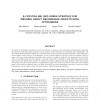Free Online Productivity Tools
i2Speak
i2Symbol
i2OCR
iTex2Img
iWeb2Print
iWeb2Shot
i2Type
iPdf2Split
iPdf2Merge
i2Bopomofo
i2Arabic
i2Style
i2Image
i2PDF
iLatex2Rtf
Sci2ools
IMR
2003
Springer
2003
Springer
A Crystalline, Red Green Strategy for Meshing Highly Deformable Objects with Tetrahedra
Motivated by Lagrangian simulation of elastic deformation, we propose a new tetrahedral mesh generation algorithm that produces both high quality elements and a mesh that is well conditioned for subsequent large deformations. We use a signed distance function defined on a Cartesian grid in order to represent the object geometry. After tiling space with a uniform lattice based on crystallography, we use the signed distance function or other user defined criteria to guide a red green mesh subdivision algorithm that results in a candidate mesh with the appropriate level of detail. Then, we carefully select the final topology so that the connectivity is suitable for large deformation and the mesh approximates the desired shape. Finally, we compress the mesh to tightly fit the object boundary using either masses and springs, the finite element method or an optimization approach to relax the positions of the nodes. The resulting mesh is well suited for simulation since it is highly str...
| Added | 07 Jul 2010 |
| Updated | 07 Jul 2010 |
| Type | Conference |
| Year | 2003 |
| Where | IMR |
| Authors | Neil Molino, Robert Bridson, Joseph Teran, Ronald Fedkiw |
Comments (0)

